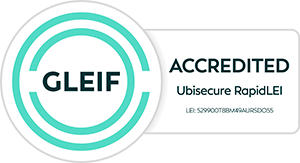LEI Statistics | Key Insights
Bloomberg LEI, London Stock Exchange (LSEG), Ubisecure RapidLEI.
Ubisecure RapidLEI is a Global LEI Foundation (GLEIF) accredited LEI Issuer and is approved to issue and manage LEIs throughout the globe. This LEI statistics page presents changes, key trends and insights into the LEI ecosystem, focusing on the largest LEI Issuers with a worldwide presences: Bloomberg LEI, RapidLEI and LSEG.

Validated vs. Non-Validated LEIs
LOUs validate LEI application data to either fully corroborated, partially corroborated, or Entity Supplied Only (ESO) levels. To be referred to as “validated” in our Stats, we require the LEI to be either fully or partially corroborated.
Verified Organization LEIs issued in 2024
RapidLEI
Bloomberg LEI
London Stock Exchange LEI
Verified Organization LEIs issued in 2023
RapidLEI
Bloomberg LEI
London Stock Exchange LEI
Verified Organization LEIs issued in 2022
RapidLEI
Bloomberg LEI
London Stock Exchange LEI
Total LEI Universe
Combines new LEIs issued from all accredited LOUs.

Total LEIs
Global Growth Rate
Regulations mandating/recommending LEI
- Who collects the data for the LEI statistics?
- What is a Validated LEI vs. a non-Validated, or Entity Supplied Only (ESO) LEI?
- What is the LEI Conformity Flag?
- What are Transferred Legal Entity Identifiers?
- What does LEI Renewal Rate mean?
- What are Challenges made on LEI data accuracy?
- How does the GLEIF report data quality issues?
- Which LOUs are included in the LEI stats?
Who collects the data for the LEI statistics?
LEI statistics and LEI graph data originate from the Global LEI Index – the data collected, maintained and published by the Global LEI Foundation (GLEIF). RapidLEI connects to the LEI Index to collect real-time data, and we supplement with data from monthly GLEIF business reports and GLEIF stats to compare LEI Issuers (formally known as GLEIF-accredited Legal Operating Units).
What is a Validated LEI vs. a non-Validated, or Entity Supplied Only (ESO) LEI?
RapidLEI and our RA partners define Validated LEIs as issued LEIs where application data has been corroborated, i.e. verified against approved registry sources, either in full or partially.
Non-Validated LEIs are defined as issued LEIs where application data has not been corroborated. Application data is supplied only by the applicant, hence the Entity Supplied Only (ESO) classification.
What is the LEI Conformity Flag?
The upcoming LEI conformity flag is a binary indicator that will be displayed within the Legal Entity record for the completeness and quality of the legal entity reference data. This is determined against the registration and reporting policies set by the LEI ROC (Regulatory Oversight Committee).
What are Transferred Legal Entity Identifiers?
A Legal Entity Identifier is managed by a single Local Operating Units (LOU). Issued LEIs may be transferred between different LOUs at the request of the LEI owner. The stats show:
- LEIs Transferred In: the number of LEIs that the LOU has imported under its management at the request of the LEI owners.
- LEIs Transferred Out: the number of LEIs the LOU has been required to transfer to a different LOU at the request of the LEI owners.
What does LEI Renewal Rate / LEI Lapsed Rate mean?
Legal Entity Identifiers must have entity reference data checked annually or the record will be classified as LAPSED. The Renewal Rate stat shows the % of issued LEIs that are renewed as expected annually, and hence the ratio of LEIs that otherwise fall into lapsed status.
How does the GLEIF report data quality issues?
Each month the GLEIF publishes data accuracy reports for both the entire GLEIS and specific LOUs. The data quality issues detailed in the reports are included in summary on this page.
Which LOUs are included in the LEI stats?
This resource focuses on the leading global LEI Issuers with a worldwide footprint – Ubisecure RapidLEI, Bloomberg LEI and the London Stock Exchange LEI group. The Total LEI Universe graph includes data from all the entire LEI ecosystem and all LOUs. Stats for other, more geographically focused LEI Issuers can be found on the GLEIF website.
How to renew an LEI?
If you choose to renew your LEI with Ubisecure RapidLEI, the largest LEI Issuer worldwide, you can renew your LEI up to 60 days before it expires. This preemptive renewal doesn’t reduce your LEI’s validity period but prevents it from lapsing. To get going, visit the article How do I renew my LEI in the LEI knowledge base.


